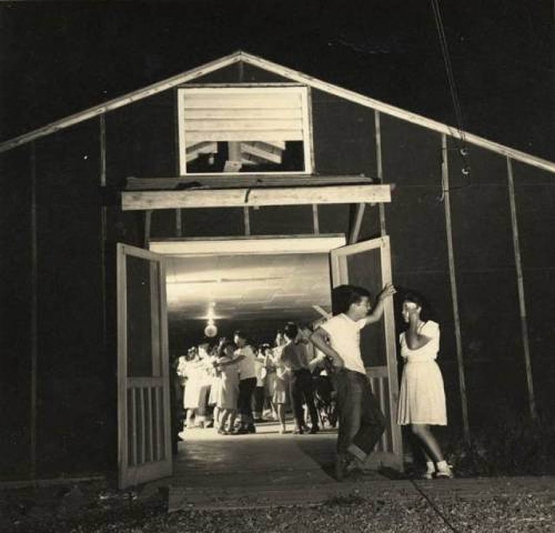Signed by President Roosevelt on December 7, 1941, Proclamation 2525 enabled the U.S. government to relocate anyone it chose from all areas believed to be of military value.
"...the President makes public proclamation of the event, all natives, citizens, denizens, or subjects of of the hostile nation or government, being of the age of fourteen years and upward, who shall be within the United States and not actually naturalized, shall be liable to be apprehended, restrained, secured, and removed as alien enemies."
Attached is a black and white plan depicting the "Rohwer Relocation Center", which was located in Desha County, Arkansas. The plan clearly illustrates how the residential huts were to be placed in addition to the churches, shops and schools.
A black and white schematic drawing depicting the "Tule Lake Relocation Center", which was located in Tule Lake, California. The plan clearly illustrates how the residential huts were to be placed in addition to the churches, shops and schools.
The attached chart shows the total number of elementary and high school students who were enrolled at the ten Japanese-American internment camps during the period leading up to March, 1943.
The attached table lists the average Japanese-American internment camp population as counted between the months of January to June of 1944. All ten camps were considered in the study.
Even under the gloomy conditions of the camps the wheels of commerce continued to turn ~and they turned out an impressive $3,526,851.77! As can clearly be seen in the plans of the camps that are offered on this site, the camps all had commercial districts where the interned families could purchase needed goods and services; the ten Japanese-American internment camps had 160 businesses operating within their gates that managed to employ 1,853 souls. The attached chart from the 1944 records of the War Relocation Authority serves to illustrate the productivity of all these assorted commercial operations that had once thrived in the camps.
Attached is a chart that served to document the occupations of all the Isei and Nesei adults who were interned during the course of the war.
A list provided by the War Relocation Authority of the seven groups that maintained ties and created various social and educational activities for the interned Japanese-Americans spanning the years 1943 through 1945. The Y.W.C.A., the Boy Scouts and the American Red Cross are just three of the seven organizations.
For years prior to W.W. II and the creation of the Japanese-American internment camps, the people of the United States had been steadily spoon fed hundreds articles detailing why they should be weary of the Japanese presence in North America; if you would like to read one that was printed as late as 1939, click here.
An interesting article, written with a sense of embarrassment regarding the injustice done to the Japanese-Americans, and published a few weeks shy of VJ-Day. The article reports on how the former internment camp families were faring after they were released from their incarceration. 55,000 Japanese-Americans chose to remain in the camps rather than walk freely among their old neighbors; one man, Takeyoshi Arikawa, a former produce dealer, remarked:
"I would like to take my people back home, but there are too many people in Los Angeles who would resent our return. These are troubled times for America. Why should I cause the country any more trouble?"
That administering government agency charged with the management of the Japanese-American internment camps was the
War Relocation Authority
, which was an arm of the U.S. Department of the Interior. Much to their credit, in 1944, this bureaucracy saw fit to published a small booklet containing the letters of many outraged American servicemen who vented their anger on the subject that their fellow Americans were being singled-out for persecution:
"...I'm putting it mildly when I say that it makes my blood boil...We shall fight this injustice, intolerance and un-Americanism at home! We will not break faith with those who died...We have fought the Japanese and are recuperating to fight again. We can endure the hell of battle, but we are resolved not to be sold out at home."
A 1944 report by the War Relocation Authority regarding the population of the Japanese-American Relocation Camp located at Tule Lake, California. The attached chart will allow the reader to understand the numbers within the population of that camp who were foreign born, U.S. born, their age and their gender.
From Amazon: The Train to Crystal City: FDR's Secret Prisoner Exchange Program and America's Only Family Internment Camp During World War II
Attached is a eye-witness account of the Los Angeles Issie and Nisei populations after having been removed from their homes and detained at Santa Anita racetrack prior to their transfer and subsequent incarceration at Manzanar, California.
In this article, First Lady Eleanor Roosevelt (1884 – 1962) attempted to play (very politically) both sides of the street, implying on the one hand that the creation of the Japanese-American internment camps seemed a reasonable measure in wartime; but the reader doesn't have to have a degree in psychology to recognize that she believed otherwise.
These assorted color photographs of the Japanese-American internment camp at Manzanar, California helped to illustrate this 1942
Collier's Magazine article by Jim Marshall as to what Manzanar was and was not, who was there and how it operated:
"All we can do here is prove that we are good sports and good Americans, and hope that people will respect us and our problems."
"Economically, the departure of the [Japanese-Americans] presented no particular problem in the cities... But it was different in the country. [They] had owned or controlled 11,030 farms valued at $70,000,000. They had produced virtually all the artichokes, early cantaloupes, green peppers and late tomatoes, and most of the early asparagus. They owned or controlled the majority of wholesale produce markets and thousand of retail vegetable stands. When they disappeared, the flow of vegetables stopped. Retail prices went up. Many vegetables vanished entirely. There were rumors of a food shortage."
"About 630 American-born Japanese over the age of 17, now at the Poston (AZ.) relocation center, were found to be openly disloyal or of questionable loyalty to the United States, the Dies subcommittee learned at its hearing yesterday in the Federal Building...Among the 630 there were 606 men and 24 women."
"It is reported by WRA (War Relocation Authority) that between January 2 and April 22, there have been 16 shooting incidents in California. Nobody was hit. It is clearly terroristic activity aimed at frightening Nisei who have the temerity to come home and try to earn a living from their farms again".

Dance at Tule Lake.
An optimistic article from 1942 that asks us to look for the sunny side of the Japanese American internment camps - after all, they never had it so good!
In the wake of the SCOTUS opinion, Korematsu v. U.S., some talk could be heard about the return of the Japanese Americans to the previous homes. This article examines the anti-Nisei attitudes in two Western states, California and Oregon. It was the conclusion that the former had become a bit more tolerant and the later a bit worse (sadly the last paragraphs, printed on brittle brown paper, withered away in our hand.)
The mass arrests of Japanese Americans began the evening of the Pearl Harbor attack:
"As the arrests began last night, Attorney General Francis Biddle announced that FDR had authorized him to apprehend as 'alien enemies', Japanese aliens considered dangerous 'to the peace and security of the U.S.A. He said that at least 1,000 Japanese nationals would be affected, but there would be 'a fair hearing for all persons apprehended.' "
